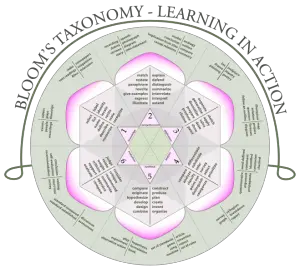 Terminology: asynchronous, synchronous, holistic education, higher and lower thinking skills
Terminology: asynchronous, synchronous, holistic education, higher and lower thinking skills
The Encarta Dictionary gives the following definition for asynchronous: “occurrence at different times: the occurrence of two or more processes at different times” and the online Yahoo dictionary defines synchronous as something “occurring or existing at the same time”. The reason why I chose these two definitions is because I find them short enough and to the point. They also hint at what to expect from an article with the title Asynchronous vs. Synchronous Interactions by T. Kung-Ming and S. Khoon-Seng.
Another concept introduced by the article is holistic education. The same Encarta Dictionary states that “holistic” means “relating to a whole: including or involving all of something”. A yahoo search directed me to the Holistic Education, Inc home page (Holistic education for Teacher: Frequently Asked Questions), a website full of resources on this topic. Reading the FAQs about holistic education and having in mind what the word holistic means, I arrived to the following understanding: in holistic education, the teachers, students and parents work together to create a curriculum that is relevant and meaningful to the socio-cultural background of the students.
In the introduction of Asynchronous vs. Synchronous Interactions it is stated that “Online learning environments strive to facilitate a holistic learning experience that takes advantage of technology…” (p.104) This means that online courses are designed in such a way that the learners will be able to apply the knowledge acquired to their own working context. And the online holistic learning experience is possible due to the asynchronous and synchronous interactions that the ICTs provide.
The concept of higher and lower thinking skills became very popular among educators in 1956, after the publication of Taxonomy of Educational Objectives by Benjamin Bloom (aka Bloom’s Taxonomy). The wikipedia article on Higher oreder thinking skills synthesizes the concept as follows: “The simplest [lower] thinking skills are learning facts and recall, while higher order skills include critical thinking, analysis and problem solving.”
Applied to online education, higher thinking skills are observed in group discussions and collaborative work, especially in the asynchronous learner-learner interaction. Synchronous learner-learner interaction is mainly characterized by lower thinking skills, as the chance of meaningful interaction decreases in large group online classes.
Disadvantages of asynchronous interaction
As stated in the abstract of the article, the authors decided to present only the advantages of asynchronous and synchronous interaction, not touching upon the disadvantages of such interactions.
In my opinion, asynchronous interaction has a few disadvantages:
– lack of spontaneity;
– the instructor’s inability to assess the learners’ ability to think on their feet (so, only higher thinking skills can be assessed);
– lack of “human factor,” especially needed for shy students who need a lot of encouragement and praise to boost their confidence.
These three disadvantages can be overcome by the use of synchronous interaction. Thus,
– lack of spontaneity in not an issue in instant messaging;
– the instructor can assed the students’ lower thinking skills through voice and videoconferencing (but of course, higher thinking skills cannot be assessed using this method);
– the “human factor” can be incorporated in synchronous interaction through the use of instant messaging and voice and videoconferencing. Instant messaging, such as yahoo Messenger and MSN, also offer the option of using emoticons.
Conclusion: In order to facilitate the needs and variety of learners in online education, it is imperative that both asynchronous and synchronous interactions are used.
